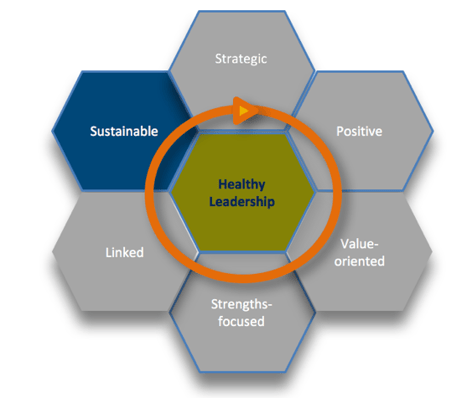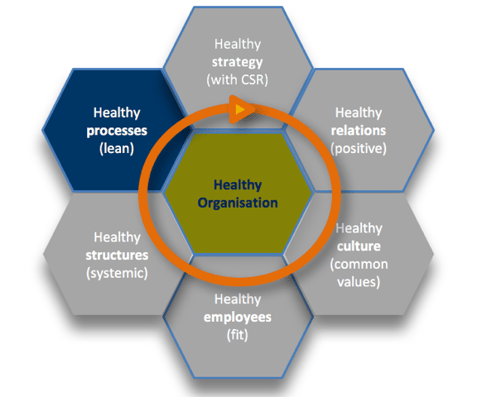Sustainable leadership in the Healthy Organisation (7/7)
This article is the last one in our series on leadership in the Healthy Organisation. Due to the positive feedback of our readers we will start a new series with the next release of our notes that will deal with the Sick Organisation (SO) and its symptoms.
We admit, “sustainable“ meanwhile has become such a stale word, that you can’t stand hearing it. By now everything is sustainable. Maybe we should have rather used the new management word of the year, “disruptive“ (FAZ of December 27th, 15), then we would at least remain within the spirit of the times, even if the meaning is completely different.
Why then “sustainable“ or “sustainable leadership“ anyhow? (see fig. 1)

Fig. 1: Sustainable leadership in the HO
The term sustainability first appeared in the 18th century (!), back then in connection with forestry (Grundwald & Kopfmüller 2012). The increasing need for wood led to an overuse of the local woods. It was the goal to enable by means of a sustainable forestry a cultivation that aimed at a high as possible yield with simultaneously continuous use. Thus, the aim was not to chop down more than what was able to grow again. Two issues thus became obvious back then already: balance and durability. It was all about the balance between utilization and regeneration with regard to a long-term time horizon. A similar behavior repeated itself regarding fishery in the 20th century, unfortunately with only moderate success, as we know. Up until the 90s the term “sustainability“ was almost exclusively limited to forestry and fishery, and played only a little role in the economic discourse. The report “Limits to growth“ by the Club of Rome published in 1972, the Brundtland-Commission in the 80s, the World Summit of Rio de Janeiro in 1992, as well as the Millennium Targets composed in 2000 by the United Nations surely rank among the preparers of today’s understanding. Despite all criticism one widely agrees today that sustainability mainly consists of the three pillars ecology, eonomy and social issues.
Since we are located in the process honey comb (see fig. 2), sustainable leadership means that processes are aligned by executives as such that they take into account and are able to fulfill ecological, economic and social criteria. A unilateral orientation towards economic aspects would cause imbalances just as a unilateral orientation towards social issues or ecological interests. We assume that imbalances can be accepted on short-term, for example in order to be able to react quickly to market fluctuations. However, they must always remain within specific (legal) boundaries with the aim of achieving a balance with regard to the three pillars in the medium and long run.

Fig. 2: HO Modell: healthy processes
A further aspect is of relevance here. Even if process can be sustainably aligned in the sense of the above-mentioned criteria, they can nevertheless be complicated, rigid and slow. We speak of “blown-up“ processes. Some organisations almost suffocate from their regulatory frenzy and lack of assumption of responsibility. The opposite has been observed for some years now as well: processes are made leaner, in order to increase profitability by means of efficiency or by treating resources with care. But here as well exaggerations can become weaknesses: lean becomes meagreand meagre is unhealthy. For all one’s worth things are made leaner - and things often don’t withstand it, just think of the often scarce quality even with regard to premium products (refer to the millionfold product recalls in the automobile sector), the lacking clarity of roles with regard to the assignment of tasks (“who does what if there is nobody left?“) or by means of the popular “outsourcing“ (e.g. of IT processes), that often seem significantly more cost-effective on the drawing board, but often entail non-measurable subsequent costs (frustrated employees, no contact person, frequent iteration loops etc.).
Which practicable approaches to lead in a sustainable way can you derive from this?
If from your point of view the priorization is clear, please assess in the next step thedimension with regard to the significance of the three criteria. The sum must add up to 100, e.g.: economy = 65, ecology = 20, social issues = 15.
Then reflect the strengths and weaknesses of this distribution and consider if you want and are able to change anything. If so, concentrate on the processes that you are actually able to change.
Subsequently evaluate on a scale from 1 to 10 (1 for meagre and 10 for blown-upprocesses) how you evaluate this continuum for your organisation or your department?
Again consider afterwards why you came to this assessment, how appropriate you think this result is and which measures you want to derive from this.
If you want to believe futurologists, the trend towards sustainably produced products will continue. Today already companies whose activities promote sustainability profit from consumers who are becoming increasingly critical and who want to know exactly how their economies work. The most recent results of the Climate Summit in Paris are very promising and point towards this direction. Healthy Organisations are managed by people that practice sustainable leadership and thus contribute to the fact that sustainability is not a hackneyed cliché that every organisation should have anchored in its guiding principle, but a significant factor for the future success of the entire company.

